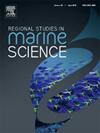Methods for monitoring abalone Young-of-the-Year in the Japan Sea: Habitat utilization and depth distribution of Haliotis species
IF 2.4
4区 环境科学与生态学
Q3 ECOLOGY
引用次数: 0
Abstract
The four abalone species Haliotis discus discus, H. madaka, H. gigantea, and H. diversicolor are important fisheries resources in Japan. However, the stock abundance of these species has declined. Fluctuations in abalone young-of-the-year (YOY) stocks may significantly influence adult stock abundance. Monitoring methods for YOY are proposed which clarify habitat shifts associated with growth, particularly in H. discus discus and H. diversicolor. While only partial trends could be inferred for H. madaka and H. gigantea. For all four species, YOY were frequently observed in gaps between rocks or beneath sea urchins in these gaps. In H. discus discus and H. diversicolor, a habitat shift was observed with growth, transitioning from cryptic habitats (e.g., rock gaps and areas under sea urchins) to more exposed habitats. The depths at which YOY were found varied each year. However, H. discus discus and H. diversicolor were found in shallower waters than H. madaka and H. gigantea; the former two species appeared to migrate from deeper to shallower areas as they grew. These findings provide essential insights for improving abalone YOY survey methods. Additionally, it was recognized that, since catch-per-unit-effort trends varied among the four species, precise YOY species identification is crucial for effective monitoring.
日本海年幼鲍鱼的监测方法:生境利用和鲍鱼的深度分布
四种鲍鱼是日本重要的渔业资源,它们分别是褐鲍鱼、大褐鲍鱼、大褐鲍鱼和多彩鲍鱼。然而,这些物种的种群丰度已经下降。鲍鱼幼龄种群的波动可能会显著影响成年种群的丰度。提出了不同年际的监测方法,以澄清与生长相关的生境变化,特别是在麻麻和麻麻中。而对madaka和H. gigantea只能推断出部分趋势。对于这四个物种,它们经常在岩石之间的缝隙中或这些缝隙中的海胆下面观察到YOY。在铁饼和多彩铁饼中,随着生长,栖息地发生了变化,从隐蔽的栖息地(如岩石缝隙和海胆下的区域)过渡到更暴露的栖息地。yy被发现的深度每年都在变化。然而,在较浅的水域中发现了赤鳉和异色赤鳉,而在较浅的水域中发现了赤鳉和巨鳉;前两个物种似乎在生长过程中从较深的区域迁移到较浅的区域。这些发现为改进鲍鱼年同比调查方法提供了重要的见解。此外,人们认识到,由于四种物种的单位努力渔获量趋势各不相同,因此准确的年度物种鉴定对有效监测至关重要。
本文章由计算机程序翻译,如有差异,请以英文原文为准。
求助全文
约1分钟内获得全文
求助全文
来源期刊

Regional Studies in Marine Science
Agricultural and Biological Sciences-Ecology, Evolution, Behavior and Systematics
CiteScore
3.90
自引率
4.80%
发文量
336
审稿时长
69 days
期刊介绍:
REGIONAL STUDIES IN MARINE SCIENCE will publish scientifically sound papers on regional aspects of maritime and marine resources in estuaries, coastal zones, continental shelf, the seas and oceans.
 求助内容:
求助内容: 应助结果提醒方式:
应助结果提醒方式:


